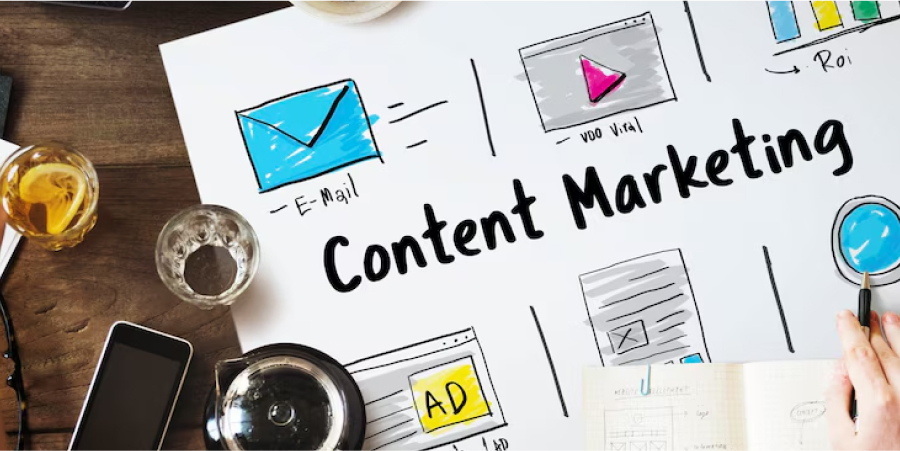Want to catch the trigger?
Results that Drive Lead
70%
Organic traffic in the first 3 months
3x
Increase in SQLs through targeted content funnels
2.5x
Content engagement across SEO and paid campaigns
50%
Boost in branded search with thought leadership content
What are Content Marketing Services?
Content Marketing Services is the process of generating demand at every stage of the funnel by building authority, nurturing trust and developing a scalable content ecosystem that supports the entire user journey.

Funnel Mapping
Understand the ICP to map pain points and align topics to the buyer journey.

Audience & Intent-Driven Content Creation
Track of long-form SEO blogs, product-led content, and content clustering to produce better ranking for transactional queries.

Aligning Content & Website Architecture
Audit and structure content to improve UX, site hierarchy, and engagement.

Content Amplification Across Channels
Ensure content visibility across relevant channels and niche platforms to boost referral traffic and engagement.
The Gap In Today’s Content Marketing Services - Solved
Most content fails to deliver due to scattered distribution and high gaps in alignment with brand objectives.
“We had content but no structured outline or specific audience.”
That’s an issue of right messaging. We strategize your content with a structured outline tailored to your unique business requirements.
“Low engagement and high drop-off even with decent website traffic.”
Even with high traffic, you face issues with conversion and engagement. Our vetted writers deliver copies that resonate with your audience’s interests.
“The content is not bringing in the right user.”
No deliverables in revenue. We’ll ensure to track content performance at every stage and optimize based on trends and user interest.
Want to Turn Your Content into Revenue-Driven Assets?
Our content marketing solution experts will target the relevant audience for your scalable growth in this competitive market.
Our Content Marketing Services
At Saffron Edge, we craft compelling narratives by ideating every facet of content strategy that intrigues customers to know more, leading to conversion.

Content Strategy Development
Plan with precision.

Authority Building
Expertise that echoes with Insight.

SEO Content Creation
Search that sells.

Multi-Format Content Creation
Diversify your messaging.

Content Distribution & Promotion
Content that resonates and travels.
Performance Tracking & Optimization
Track and optimize every effect.

Content Lifecycle Management
Refresh. Reuse. Rank.

Content Strategy Development
Plan with precision.
We map out topic clusters, keyword themes, buyer personas, and SEO choices to generate long-term plans that set the brand voice.
 Key Features
Key Features
- Topic cluster planning
- Keyword gap analysis
- Content funnel mapping
- Editorial calendar setup
Expected Results
2x
Increase in blog CTRs, 3x faster content production cycle.
Case Study Preview
See how companies like yours achieved similar results with Saffron Edge.

Authority Building
Expertise that echoes with Insight.
We ghostwrite your C-suite or internal documents for better messaging to build trust and credibility.
 Key Features
Key Features
- Content calendar + executive posts
- Industry opinion pieces, whitepapers
- Expert Q&As & POV content
- Expert interviews, industry insights
Expected Results
40%
Increase in direct traffic and brand recall in 6 months.
Case Study Preview
See how companies like yours achieved similar results with Saffron Edge.

SEO Content Creation
Search that sells.
We curate content that engages buyers and not just browsers, the kind that ranks and converts to establish ROI and grows the brand globally.
 Key Features
Key Features
- SEO content with NLP
- Featured snippet targeting
- Improvised internal link flow
- Keyword-rich, on-page SEO
Expected Results
70%
Boost in non-branded traffic within 3 months.
Case Study Preview
See how companies like yours achieved similar results with Saffron Edge.

Multi-Format Content Creation
Diversify your messaging.
We step beyond blog write-ups, creating content that engages the audience to consume content in different styles and channels.
 Key Features
Key Features
- Case studies, infographics
- Podcast, video scripts, and carousels
- Personal branding content
- Business one-pagers
Expected Results
3x
Engagement on social and email campaigns
Case Study Preview
See how companies like yours achieved similar results with Saffron Edge.

Content Distribution & Promotion
Content that resonates and travels.
At Saffron Edge, we ensure every content asset reaches its highest potential with effective strategic content seeding.
 Key Features
Key Features
- Paid promotion across channels
- Guest posts and PR content partnerships
- Nurture emails and retargeting ads
- Paid content syndication
Expected Results
2x
Content reach and 30% higher conversion from content first leads.
Case Study Preview
See how companies like yours achieved similar results with Saffron Edge.
Performance Tracking & Optimization
Track and optimize every effect.
We optimize content based on performance, trends, and targeted users’ interests for relevant engagement that turns into conversion.
 Key Features
Key Features
- Engagement heatmap
- Conversion tracking per content type
- A/B testing for CTAs and formats
- Scroll-depth analysis
Expected Results
50%
Improvement in average content ROI over 90 days.
Case Study Preview
See how companies like yours achieved similar results with Saffron Edge.

Content Lifecycle Management
Refresh. Reuse. Rank.
Old content doesn’t mean outdated work. We identify the ones still relevant and would perform if revived at the right time across the right channel.
 Key Features
Key Features
- Keyword re-optimization and metadata rewrites
- Competitor gap closure
- Content pruning and redirection
- Multimedia repackaging
Expected Results
40%
More leads with 3x average session duration.
Case Study Preview
See how companies like yours achieved similar results with Saffron Edge.
How our Content Marketing Services Drive ROI
Our content marketing solution approach is systematic, data-driven, and designed to compel viewers to act rather than just engage.

Deep Audience Insight
Understand user intent and behaviour to shape messaging that connects.
- Persona messaging
- Funnel stages
- ICP alignment
- Pain-point research

SEO Driven Planning
Crafting scalable strategies around search, trend and demand.
- Keyword research
- Topic clustering
- SERP analysis
- Content gaps

Content Creation & Distribution
Build and promote content assets aligned with goals and search.
- Blogs & guides
- Landing pages
- Case studies
- Email flows

Performance Optimization
Improve based on analytics, feedback and results.
- A/B testing
- Heatmap tracking
- ROI reporting
- Conversion audits
Our Tech Stack = Your Growth Stack
- Marketing
- Design
- Development
- Data Analytics
- Marketing Automation
Why Choose Saffron Edge for Website Conversion Optimization?
We combine deep expertise with a performance-driven mindset to create content strategies that give exposure to your targeted business outcomes.
Strategic & Research Backed Planning
Saffron Edge’s approach is to create with intent, using relevant keyword data, audience understanding, and funnel insights to direct every piece of content.
SEO-First Content Development
Every content is built by our vetted writers with SEO principles from keyword mapping to schema, which ensures the content ranks and generates relevant traffic.
Creative Storytelling
Our content resonates with the audience emotionally and drives long-form blogs that connect across multiple channels with visuals, delivering an impactful experience.
Omnichannel Distribution Strategy
We help you reach the right audience at the right place and time, through the right channel and mode, with influencer amplification.
Full-Funnel Content Execution
We ensure content supports every touchpoint in your buyer’s journey, with blogs to BOFU landing pages, all of which connect with the user.
Performance Reporting
We provide detailed performance reports, engagement insights, rankings, leads and changes needed to maximize ROI.
Content That Converts And Produces Results
Our online content marketing service creates content that drives action and converts those leads, producing results. We’ll craft compelling narratives that intrigue customers to know more.
Case Studies
We drive exceptional results for every client
Blogs
We explore and publish the latest & most underrated content before it becomes a trend.
9 min read
B2B Content Marketing Examples: Success Stories and Key Takeaways
By Sabah NoorFrequently Asked Questions
What is a Content Marketing Service?
Content marketing service is the process of structuring and outlining content that aligns with your audience’s interest, exhibited on the relevant channel.
How will content help in generating revenue?
It gets the right audience engagement and not just traffic that browses, but the one that resonates with your product and converts.
How can content marketing services benefit me?
Using content marketing services will give your brand global exposure, engage users, and contribute to your ROI.
What are the different formats of content you provide?
Our content marketing service provides expert-backed content for social media channels, whitepapers, ICPs, datasheets, blogs, websites, and more.
What industries do you cater to?
We cater to multiple industries with our specialisation in B2B, SaaS, healthcare, finance, and more, serving content that builds authority and addresses customer pain points.

Get Free SEO Audit










































































